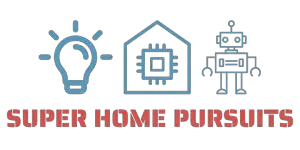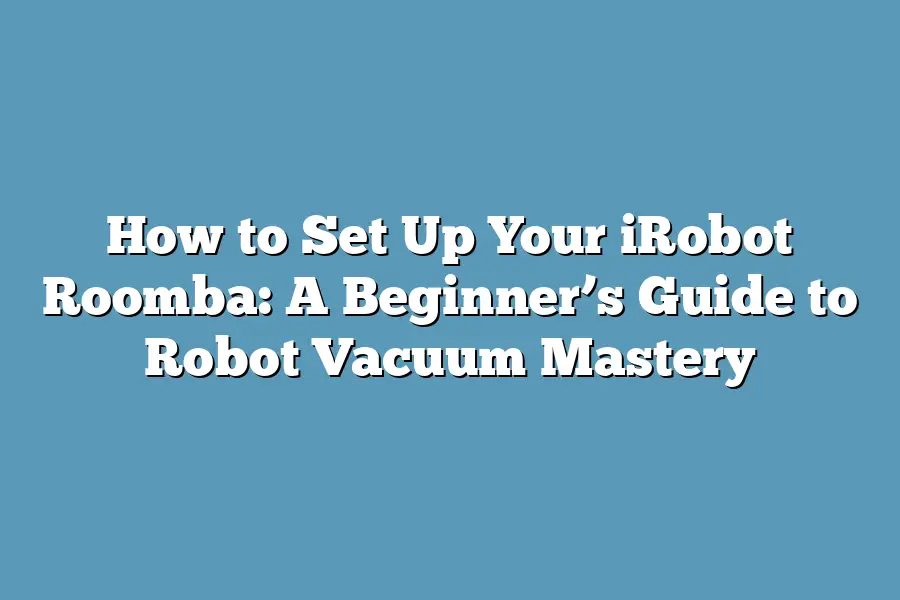To set up your iRobot Roomba, start by charging it for at least 30 minutes before first use. Then, place the Roomba on a flat surface and press the power button to turn it on. The Roomba will automatically begin to clean the floor, using its sensors to navigate around furniture and other obstacles. You can also customize your cleaning experience by adjusting the mode and schedule through the iRobot Home App.
I still remember the day I brought home my first iRobot Roomba.
It was like having a personal butler, minus the snootiness.
With a few simple clicks, this little robot vacuum would transform my floors from chaotic to calm.
But let me tell you, it wasn’t until I dove deep into its features and settings that I truly became a Robot Vacuum Master.
In this guide, I’ll share with you the same secrets and techniques that have allowed me to tame the untamed messes of my home (and yours too!).
From setting up the hardware to programming your Roomba for optimal cleaning routes, edge detection, and more – we’re going to cover it all.
So if you’re ready to take your robot vacuum game to the next level, let’s get started!
Table of Contents
Setting Up Your Roomba: Hardware Installation
Ah, the moment you’ve all been waiting for – setting up your new iRobot Roomba!
It’s like unwrapping a shiny new toy (only better, because it’s a robot vacuum that’ll make your life easier).
In this section, I’ll walk you through the hardware installation process step-by-step.
So, grab your Roomba and let’s get started!
Charging Up
First things first – you need to charge your Roomba.
It comes with a charging dock, which is super convenient.
Just place it on the dock, and let the magic happen.
- Make sure the charging dock is plugged into a power outlet (don’t worry, I won’t tell anyone you’re using it to juice up your robot vacuum instead of your phone).
- The Roomba’s battery icon will start flashing when it’s charging – it’s like a little green light saying, “Hey, I’m getting some serious juice!”
Batteries (If You Need Them)
Now, if you have the newer models that come with rechargeable batteries, great!
Just place them on their charging dock, and let them get recharged.
Easy peasy.
- If your Roomba doesn’t come with rechargeable batteries (like older models), don’t worry – we’ve got this covered. You can always purchase replacement batteries online or at a local electronics store.
Side Brush Installation
Time to attach those side brushes!
They help the Roomba clean those pesky corners and edges.
- Locate the side brush attachment points on your Roomba (it’s usually marked with an arrow).
- Gently push the side brushes onto the attachment points until they click into place. You might need to wiggle them a bit – don’t worry, it’s not as delicate as it sounds!
Main Brush Placement
Now we’re getting to the good stuff!
The main brush is what helps the Roomba pick up dirt and debris.
- Find the main brush attachment point on your Roomba (it’s usually marked with a label).
- Place the main brush onto the attachment point, making sure it’s securely fastened. You might need to adjust it slightly – don’t worry if it takes a few tries!
Tips for Proper Alignment
Before you start using your Roomba, make sure everything is properly aligned and attached.
- Double-check that all the brushes are securely fastened.
- Ensure the charging dock is placed in a safe location where your Roomba can easily access it when it needs to recharge.
That’s it!
Your iRobot Roomba is now set up and ready to roll (or should I say, vacuum?).
With these simple steps, you’ll be well on your way to becoming a robot vacuum master.
Happy cleaning!
Programming Your Roomba: Basic Navigation and Scheduling
You just brought home your shiny new iRobot Roomba, and you’re eager to unleash its robotic wonder on your floors.
But before you start vacuuming like a pro, it’s essential to understand how to program your Roomba for optimal performance.
Let’s dive into the different navigation modes that’ll help you master the art of robot vacuum mastery!
Navigation Modes 101: Clean, Edge, and Spot
When you first power on your Roomba, you’ll notice three main navigation modes: Clean, Edge, and Spot.
Each mode serves a specific purpose, so let’s break them down:
- Clean: This is the default mode that covers the entire room or area you’ve defined for cleaning. The Roomba will methodically cover every inch of floor space, leaving no dirt or debris behind.
- Edge: As the name suggests, Edge mode focuses on cleaning along walls and edges. Perfect for getting those pesky crumbs and dust bunnies that accumulate near baseboards!
- Spot: This mode is ideal for targeted cleaning sessions. You can use Spot to clean a specific area, like around furniture or under a couch.
Now that you know the basics of navigation modes, let’s get into the fun part – setting up your Roomba for scheduled cleaning sessions!
Scheduled Cleaning Sessions: Because Life Gets Busy
Who doesn’t love having their floors cleaned while they’re busy tackling other tasks?
With iRobot’s scheduling feature, you can program your Roomba to clean at specific times of the day.
Here’s how:
- Open the iRobot Home app and navigate to the “Roomba” section.
- Tap on “Scheduling” and select the time you want your Roomba to start cleaning.
- Choose the desired navigation mode (Clean, Edge, or Spot) for that session.
Customized Cleaning Routes: Because Every Home is Unique
Your Roomba comes equipped with advanced sensors and mapping technology.
This means it can learn your home’s layout and create a customized cleaning route based on its findings!
To take advantage of this feature:
- Allow the Roomba to map out your space by running it in Clean mode until it’s completed its initial scan.
- Once mapped, you can customize the cleaning route by adjusting the navigation modes for specific areas.
Pausing or Stopping Cleaning Sessions: Because Life Doesn’t Always Go According to Plan
Sometimes, unexpected events might require you to pause or stop your Roomba mid-cleaning session.
Don’t worry; iRobot’s got you covered!
To pause or stop a cleaning session:
- Open the iRobot Home app and navigate to the “Roomba” section.
- Tap on “Scheduling” and toggle the “Pause” or “Stop” button.
Tips for Optimizing Navigation and Scheduling: A Little Goes a Long Way
To get the most out of your Roomba’s navigation and scheduling features, keep these tips in mind:
- Keep it tidy: Make sure to clean up any clutter or obstacles that might interfere with your Roomba’s movement.
- Plan ahead: Schedule cleaning sessions around your daily routine to minimize disruptions.
- Experiment with modes: Try out different navigation modes to find what works best for your unique home layout and needs.
By following these tips, you’ll be well on your way to mastering the art of robot vacuum mastery!
Advanced Features: Edge Detection, Avoidance, and Maintenance
As you’ve mastered the basics of your iRobot Roomba (congrats!), it’s time to unleash its advanced features and take your robot vacuum game to the next level.
In this section, we’ll dive into edge detection technology, explore how to customize avoidance features, and provide step-by-step instructions for scheduling maintenance sessions and troubleshooting common issues.
Edge Detection: The Power of Precision
Edge detection is a revolutionary feature that allows your Roomba to detect and navigate around edges, like stairs or countertops.
This advanced tech uses a combination of sensors and algorithms to create a precise map of your space, ensuring your robot vacuum can avoid obstacles with ease.
To enable edge detection:
- Make sure you’re running the latest firmware (check for updates in your iRobot account)
- In the Roomba’s settings, toggle “Edge Detection” on
- Adjust the sensitivity level to your liking (I prefer a medium setting for optimal performance)
With edge detection enabled, your Roomba will now detect edges and adjust its navigation accordingly.
This feature is especially useful when you have pets or stairs in the house – it’ll help prevent accidents and ensure a smooth cleaning experience.
Avoidance Features: Customizing Your Roomba’s Route
Now that we’ve got edge detection up and running, let’s focus on customizing your Roomba’s avoidance features.
These settings allow you to tailor your robot vacuum’s behavior when encountering specific obstacles like stairs, pets, or clutter.
To enable and customize avoidance features:
- In the Roomba’s settings, toggle “Avoidance” on
- Select the type of obstacle you want to avoid (e.g., stairs, pets)
- Adjust the sensitivity level for each obstacle (I recommend starting with a medium setting and adjusting as needed)
For example, if you have pets that like to lounge around during cleaning sessions, you can set your Roomba to avoid them.
This feature is particularly useful for pet owners who want to keep their furry friends safe while they’re away.
Scheduling Maintenance Sessions: Keep Your Roomba in Tip-Top Shape
As with any machine, regular maintenance is crucial to ensure your iRobot Roomba continues to perform at its best.
In this section, we’ll cover how to schedule maintenance sessions and cleaning around specific objects or areas.
To schedule a maintenance session:
- Open the iRobot Home app on your smartphone
- Tap “Settings” and then select “Maintenance”
- Choose the type of cleaning you want to perform (e.g., spot clean, deep clean)
- Set a reminder for when you’d like to start the cleaning session
When it’s time for maintenance, follow these steps:
- Clear any clutter or obstacles from your Roomba’s path
- Remove any large objects or furniture that may interfere with the cleaning process
- Allow your Roomba to perform the scheduled cleaning task
Troubleshooting Common Issues: Navigation and Maintenance
As you’re mastering your iRobot Roomba’s advanced features, it’s inevitable that you’ll encounter some bumps along the way.
Don’t worry – we’ve got you covered!
Here are some common issues you might face during navigation and maintenance:
- Navigation issues: If your Roomba seems stuck or unable to navigate around an obstacle, try restarting the cleaning session or adjusting the avoidance features.
- Maintenance challenges: If your Roomba is having trouble cleaning around a specific object or area, adjust the cleaning path or consult the user manual for guidance.
By following these advanced features and troubleshooting tips, you’ll be well on your way to becoming a robot vacuum mastery expert!
Remember to stay patient, persistent, and always keep your iRobot Roomba’s edge detection technology up to date.
Happy cleaning!
Final Thoughts
As I wrap up this beginner’s guide to robot vacuum mastery, I’m reminded that setting up your iRobot Roomba is just the first step in achieving a cleaner, more efficient home.
With these simple steps and tips, you’ve empowered yourself to take control of your floors and schedule cleaning sessions that fit your busy lifestyle.
As you continue to experiment with your Roomba’s advanced features, remember that it’s all about finding the right balance between navigation and maintenance.
By prioritizing edge detection, customization, and troubleshooting, you’ll be well on your way to mastering the art of robot vacuuming.
So go ahead, kick back, and let your Roomba do the dirty work for you.
With its help, you’ll have more time to focus on what really matters – or simply enjoy a stress-free life with cleaner floors.


